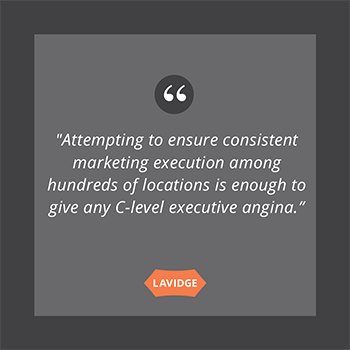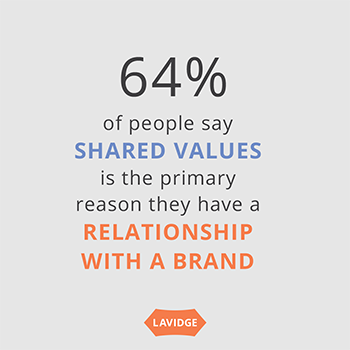Sign up for our LAVY email
and get our bi-monthly newsletter.
 You’re hooked.
You’re hooked.
The national advertising campaign for Ease Z Fitness makes the new chain of athletic clubs look amazing. Instead of pricey personal trainers, the clubs feature interactive demonstration kiosks by each machine. You’re especially impressed by the towel stations situated throughout the club.
You’re compelled to visit the gym but disappointed when you arrive. The inside of the center doesn’t look like the commercial. No towel stations. The kiosks aren’t functional. And you’re immediately offered an expensive personal trainer.
Why is there such a disconnect between the national brand and local reality?
That question has long vexed companies that have multiple locations throughout the country. From fitness centers to hair salons, and from nail salons to massage studios, ensuring brand consistency of marketing campaigns and the in-store experience across all stores isn’t easy. Attempting to ensure consistent marketing execution among hundreds of locations is enough to give any C-level executive angina.
It shouldn’t be surprising that some local operators and franchisees aren’t perfect at ensuring that their stores are synched with national branding strategy and implementation. After all, they are struggling to operate a business. Opening on time, hiring, making payroll, tracking inventory, keeping the lights on—these are what mostly occupy minds of local proprietors. Besides, they’re not marketers and may not fully understand the importance of brand alignment.
If individual locations don’t carry national branding forward, it can harm the consumer experience and damage the parent company’s hard-earned reputation and brand equity. The money spent on national branding—advertising, public relations, mobile apps, branded creative, and more—might as well be nonexistent if the consumer doesn’t experience them on a local level.
According to marketing guru and best-selling author Seth Godin, “A brand's value is merely the sum total of how much extra people will pay, or how often they choose, the expectations, memories, stories and relationships of one brand over the alternatives.” This is why national companies care about local branding execution. You need only head to your closest Apple store to see how attention to detail matters—every poster, each display and products on shelves are arranged just so. Without this, the Apple brand would be tarnished and customers might not pay more for an Apple-branded product when an Android will do just fine.
Apple doesn’t allow its local stores—in early 2019 there were 506 of them across 24 countries—to deviate from brand standards. Granted, all Apple Stores are company-owned. That gives Apple greater authority of what goes on within every store’s walls. Franchise-based companies don’t usually have such oversight of their stores. And they often find it difficult to ensure that local marketing efforts stick with brand standards in their retail advertising efforts including marketing materials. Where the national headquarters doesn’t take a heavy hand or provide solutions, local stores will find shortcuts for their market that sometimes make it appear they are a completely different company.
Businesses that are looking for better local compliance would be smart to consider a few easy tactics for effective brand management. Here are a few.
Franchisees who are running and gunning all day often don’t have time to review brand standards. From creating and placing regional ads to in-store branding, proprietors will take the path of least resistance. This can lead to ads that don’t adhere to brand standards and incorrectly placed in-store materials.
Brands should keep things simple to help improve compliance. Create foolproof instructions and guides to help local operators understand exactly what they need to do. Supply pictures of correct brand usage and placement. Provide templated display ads.
Flexibility and freedom are nice, but they can work against national/local brand alignment. If there’s more than one way to do something—design an ad, hang a poster, arrange fixtures—then things can go wrong. Decrease mistakes by not providing opportunities for franchisees to zig when you want them to zag. Franchising World’s Ryan Vaspra says that local advertising and marketing programs need “to be turnkey and frictionless. If all the franchisees have to do is say ‘yes,’ it will be easy for them to opt in” and comply.
National brands that can’t police their many local stores often engage regional advertising and marketing agencies with the task. Holding an agency accountable for flawless local execution is an excellent way to ensure brand adherence.
If local stores have an incentive to stick with well-defined national standards, brand observance will surely improve. Establish a contest that will recognize stores for local branding excellence. Financial rewards work well, of course.
National brands would be well served to stay close to their local operators. Frequent status calls are excellent ways to remain top of mind. Marketing and brand compliance should be standard segments of these conversations.
LAVIDGE, an Arizona-based franchise marketing agency, is experienced in aligning branding across multi-location retail services businesses—both local and national.
To learn more, give us a call at 480.998.2600 or send email to [email protected].
Here are four best practices to ensure that local advertising complies with national brand standards. How are you doing?
Fund the program. By combining the national advertising fund with local marketing dollars, you can create one national-local fund committed to producing the biggest impact where the cash register rings: the local level.
Select the proper agency, technology and toolset. There are agencies and other companies that can implement and manage local advertising at scale, as well as manage it with limited resources.
Centralize ad creation. Produce brand video, pay-per-click and display ads for each location. PPC and display ads are neither difficult nor expensive to create and localize.
Provide regular reports. Whether it is a spreadsheet sent to each franchisee or an integrated dashboard, provide transparent spending visibility for each location.

This article is a brief abstract of our exclusive and authoritative study that takes the guesswork out of advertising and marketing retail services. Rather than speculating about what will drive consumers to action, we've asked them.
Sign up for our LAVY email
and get our bi-monthly newsletter.